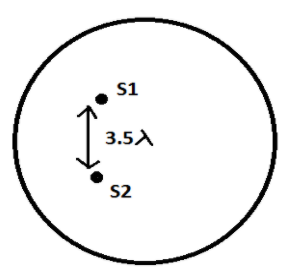
Find the number of maximas obtained on the spherical surface.


Answer
558.3k+ views
Hint: For constructive interference, path difference is \[\text{ }\!\!\Delta\!\!\text{ = n }\!\!\lambda\!\!\text{ }\] and the phase difference is \[\text{ }\!\!\theta\!\!\text{ = 2n }\!\!\pi\!\!\text{ }\] . Using the relation between \[\text{ }\!\!\lambda\!\!\text{ }\] and \[\text{ }\!\!\theta\!\!\text{ }\], calculate order of interference \[\text{(n)}\] and then use it to calculate the number of bright fringes on one part of the screen \[\text{(m)}\]. The total number of fringes will be\[\text{2m}\]
Formulas Used:
\[\text{dsin }\!\!\theta\!\!\text{ = n }\!\!\lambda\!\!\text{ }\]
Complete answer:
In Young’s Double slit experiment, the sources of light used should be coherent sources and of the same frequency.
Two sources are said to be coherent if they are in the same phase or have a constant phase difference.
The waves from both the sources interfere on the screen constructively to give bright fringes and destructively to give dark fringes.
We know that,
\[\text{dsin }\!\!\theta\!\!\text{ = n }\!\!\lambda\!\!\text{ }\]
Where, d = separation between the slits,
\[\text{ }\!\!\theta\!\!\text{ }\] = angle depicting the relative position of the fringe
n = order of interference
\[\text{ }\!\!\lambda\!\!\text{ }\] = wavelength of the light used
Here,
\[\text{ }\!\!\theta\!\!\text{ = 9}{{\text{0}}^{\text{o}}}\] (Because fringes cannot be formed behind the sources)
\[\text{d sin9}{{\text{0}}^{\text{o}}}\text{ = n }\!\!\lambda\!\!\text{ }\]
\[\Rightarrow \text{d = n }\!\!\lambda\!\!\text{ }\] - (1)
According to the question, \[\text{d = 3}\text{.5 }\!\!\lambda\!\!\text{ }\] substituting the value in eq (1), we get,
\[\text{3}\text{.5 }\!\!\lambda\!\!\text{ = n }\!\!\lambda\!\!\text{ }\]
\[\Rightarrow \text{n = 3}\text{.5}\] - (2)
The number of bright fringes (m) is given by,
\[\text{m = 2n-1}\] - (3)
From eq (2) and eq (3), we get,
\[\text{m = 6}\]
Therefore, the number of bright fringes on the upper part of the screen is 6. Similarly, there will be 6 bright fringes on the lower part of the screen too.
So, the total number of fringes is
\[6+6=12\]
Total number of bright fringes formed on the screen is 12.
Note:
In young’s double slit experiment, bright and dark fringes of the same size appear alternatively on the screen. Since, we are using a spherical surface; the brightness of the fringes will decrease towards the center of the screen. Whereas, when we use a straight screen, the brightness of the fringes decrease as we move away from the center of the screen.
Formulas Used:
\[\text{dsin }\!\!\theta\!\!\text{ = n }\!\!\lambda\!\!\text{ }\]
Complete answer:
In Young’s Double slit experiment, the sources of light used should be coherent sources and of the same frequency.
Two sources are said to be coherent if they are in the same phase or have a constant phase difference.
The waves from both the sources interfere on the screen constructively to give bright fringes and destructively to give dark fringes.
We know that,
\[\text{dsin }\!\!\theta\!\!\text{ = n }\!\!\lambda\!\!\text{ }\]
Where, d = separation between the slits,
\[\text{ }\!\!\theta\!\!\text{ }\] = angle depicting the relative position of the fringe
n = order of interference
\[\text{ }\!\!\lambda\!\!\text{ }\] = wavelength of the light used
Here,
\[\text{ }\!\!\theta\!\!\text{ = 9}{{\text{0}}^{\text{o}}}\] (Because fringes cannot be formed behind the sources)
\[\text{d sin9}{{\text{0}}^{\text{o}}}\text{ = n }\!\!\lambda\!\!\text{ }\]
\[\Rightarrow \text{d = n }\!\!\lambda\!\!\text{ }\] - (1)
According to the question, \[\text{d = 3}\text{.5 }\!\!\lambda\!\!\text{ }\] substituting the value in eq (1), we get,
\[\text{3}\text{.5 }\!\!\lambda\!\!\text{ = n }\!\!\lambda\!\!\text{ }\]
\[\Rightarrow \text{n = 3}\text{.5}\] - (2)
The number of bright fringes (m) is given by,
\[\text{m = 2n-1}\] - (3)
From eq (2) and eq (3), we get,
\[\text{m = 6}\]
Therefore, the number of bright fringes on the upper part of the screen is 6. Similarly, there will be 6 bright fringes on the lower part of the screen too.
So, the total number of fringes is
\[6+6=12\]
Total number of bright fringes formed on the screen is 12.
Note:
In young’s double slit experiment, bright and dark fringes of the same size appear alternatively on the screen. Since, we are using a spherical surface; the brightness of the fringes will decrease towards the center of the screen. Whereas, when we use a straight screen, the brightness of the fringes decrease as we move away from the center of the screen.
Recently Updated Pages
Master Class 12 Economics: Engaging Questions & Answers for Success

Master Class 12 Maths: Engaging Questions & Answers for Success

Master Class 12 Biology: Engaging Questions & Answers for Success

Master Class 12 Physics: Engaging Questions & Answers for Success

Basicity of sulphurous acid and sulphuric acid are

Master Class 12 Business Studies: Engaging Questions & Answers for Success

Trending doubts
How much time does it take to bleed after eating p class 12 biology CBSE

Explain sex determination in humans with line diag class 12 biology CBSE

Differentiate between homogeneous and heterogeneous class 12 chemistry CBSE

When was the first election held in India a 194748 class 12 sst CBSE

Explain sex determination in humans with the help of class 12 biology CBSE

December 10th of 1948 is an important day in the history class 12 sst CBSE




